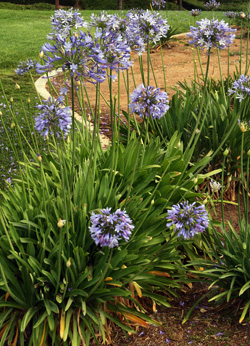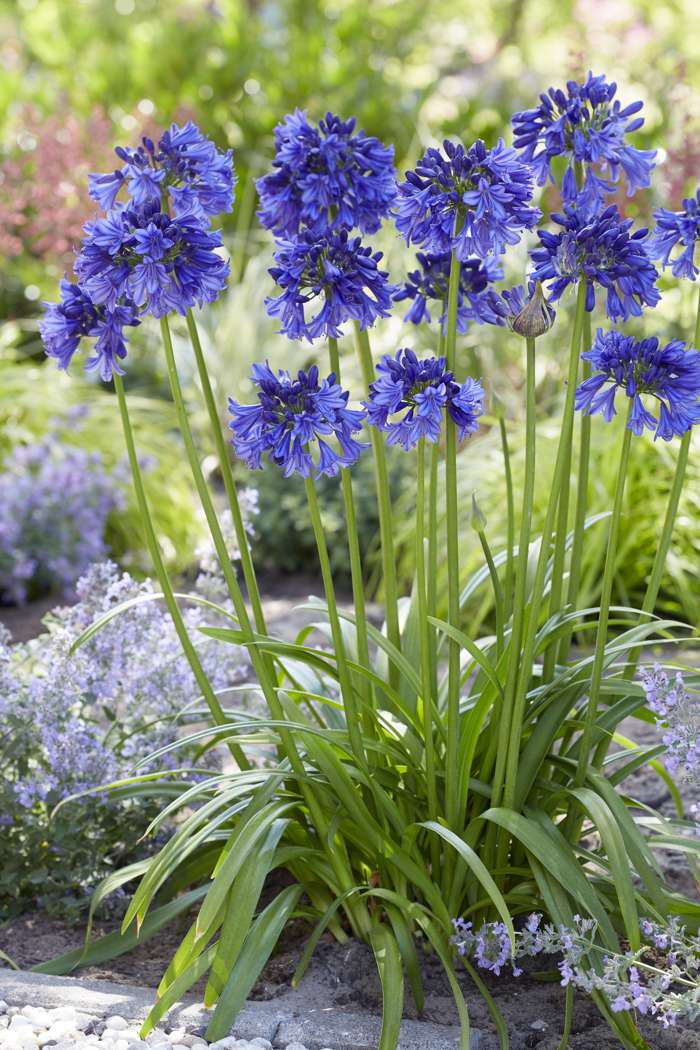Agapanthus Expanding Conditions: Soil, Sunlight, and Watering
Agapanthus Expanding Conditions: Soil, Sunlight, and Watering
Blog Article
Understanding the Art of Agapanthus Care: Important Actions for Healthy And Balanced Development and Vivid Flowers
In the realm of gardening, the farming of agapanthus stands as a satisfying venture for those that seek to nurture these stylish flowering plants. With their striking blooms and stylish vegetation, agapanthus has actually recorded the focus of garden enthusiasts worldwide. Nonetheless, attaining ideal development and dynamic blossoms requires a nuanced method that encompasses different vital steps. From picking the ideal range to mastering pruning methods, the journey in the direction of growing growing agapanthus plants is diverse and holds the crucial to opening the complete capacity of these botanical gems.

Picking the Right Agapanthus Selection

When selecting the right Agapanthus variety for your garden, consider factors such as climate viability, blossom shade, and development routine. Agapanthus, frequently called Lily of the Nile or African lily, can be found in a range of shades varying from tones of purple and blue to white. Pick a flower color that complements your existing garden palette to develop an unified landscape. Furthermore, consider the climate in your area to make sure the Agapanthus range you select can thrive in your details problems. Some ranges are much more tolerant of cool temperatures, while others choose warmer climates. Understanding the development behavior of various Agapanthus ranges is essential for appropriate placement within your garden. Some selections have a clumping development practice, ideal for containers or borders, while others have a more dispersing nature, appropriate for ground cover or mass plantings. By meticulously examining these elements, you can choose the perfect Agapanthus variety to boost the appeal of your garden.
Ideal Growing Problems
Thinking about the optimum environmental needs is important for effective Agapanthus cultivation. Agapanthus prospers in well-draining soil with a slightly acidic to neutral pH degree. When growing, select an area that receives full sunshine to partial shade. In hotter climates, supplying some mid-day shade can stop scorching of the fallen leaves. Agapanthus plants are sensitive to chilly temperature levels and should be safeguarded from frost throughout wintertime months.
To make certain healthy and balanced growth and dynamic blossoms, plant Agapanthus bulbs at a depth of concerning 2-4 inches and room them 8-12 inches apart. Including raw material, such as compost, to the dirt can boost drainage and fertility, promoting robust root growth. Mulching around the base of the plants assists preserve dampness and suppresses weed development. Routine watering is important, especially during the growing season, to keep the soil continually moist but not waterlogged.
Watering and Feeding Tips
Keeping appropriate moisture degrees and giving essential nutrients are vital components in the treatment regimen for Agapanthus plants. It is vital to strike an equilibrium when it comes to watering Agapanthus. These plants choose regularly moist dirt yet are prone to root rot if overwatered. During the expanding season, water deeply once a week, ensuring the dirt is well-draining to stop waterlogging. In hotter climates or throughout durations of dry spell, more frequent watering might be required to keep the dirt evenly wet. Nevertheless, decrease watering in the winter to protect against waterlogged conditions.
Fertilizing Agapanthus is necessary for advertising healthy growth and respected blooms. Use a balanced fertilizer, such as a 10-10-10 formula, in the very early spring as new growth arises. By adhering to these watering and fertilizing suggestions, you can ensure your Agapanthus plants grow and produce lively, resilient flowers.
Trimming Methods for Agapanthus
Trimming Agapanthus plants at the proper times and with appropriate techniques is vital for preserving their health and wellness and promoting ideal growth and blooming. The optimal time to prune Agapanthus remains in late winter or very early springtime prior to new growth emerges. Beginning by eliminating any type of dead or yellowing fallen leaves near the base of the plant. Cut them as close to the ground as feasible without harming the arising shoots.
Deadheading invested flowers can also reroute the plant's power into creating more blossoms instead than establishing seeds. If you desire to gather seeds for proliferation, leave some flowers to mature and completely dry on the plant.
Bear in mind to use tidy, sharp devices to make precise cuts and reduce the threat of presenting conditions. Agapanthus. Regular pruning will certainly help maintain your Agapanthus looking neat and healthy while making sure an abundant display screen of gorgeous flowers
Handling Usual Parasites and Diseases
After guaranteeing correct trimming strategies for Agapanthus, it is essential to deal with usual insects and conditions that can impact the health and wellness and vitality of these plants. One typical parasite that impacts Agapanthus is the Agapanthus gall midge.
One more usual concern is fungal fallen Look At This leave place, which offers as dark sores on the fallen leaves. To stop fungal diseases, guarantee great air circulation around the plants, avoid overhanging watering, and get rid of any kind of contaminated fallen leaves immediately. Furthermore, Agapanthus plants can experience from root rot if they are grown in inadequately draining pipes dirt. To stop this, plant Agapanthus in well-draining soil and prevent overwatering. By being watchful and taking prompt activity versus illness and bugs, you can aid your Agapanthus plants prosper and generate vibrant blossoms.

Final Thought
Finally, mastering the art of agapanthus care includes selecting the right range, providing ideal growing problems, appropriate watering and fertilizing, suitable pruning methods, and dealing with typical bugs and conditions. By complying with these necessary steps, you can guarantee healthy growth and vivid flowers for your agapanthus plants. Keep in mind to frequently monitor and keep your plants to advertise their more overall health and durability.
To ensure healthy and balanced growth and vibrant blossoms, plant Agapanthus bulbs at a deepness of regarding 2-4 inches and space them 8-12 inches apart. By complying with these watering and fertilizing pointers, you can ensure your Agapanthus plants grow and create vibrant, resilient flowers.
One common parasite that affects Agapanthus right here is the Agapanthus gall midget. Additionally, Agapanthus plants can endure from root rot if they are grown in badly draining pipes soil. By adhering to these important actions, you can guarantee healthy and balanced growth and lively blooms for your agapanthus plants.
Report this page